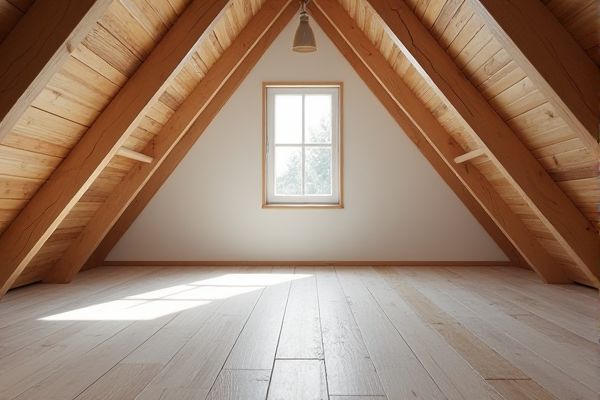
Attic linoleum flooring offers a traditional, budget-friendly option with natural materials, while vinyl plank flooring provides superior durability, water resistance, and a modern aesthetic ideal for high-traffic areas. Discover the key differences to make the best choice for your home's unique needs.
Table of Comparison
| Feature | Attic Linoleum Flooring | Vinyl Plank Flooring |
|---|---|---|
| Material | Natural oil-based composite | Synthetic PVC-based composite |
| Durability | Moderate; prone to denting and wear over time | High; scratch-resistant and long-lasting |
| Water Resistance | Low; vulnerable to moisture damage | High; waterproof and suitable for moist areas |
| Installation | Glue-down or floating; requires smooth subfloor | Click-lock or glue-down; DIY friendly |
| Maintenance | Regular cleaning; prone to staining | Low maintenance; easy to clean |
| Appearance | Matte finish; traditional style | Realistic wood-look textures |
| Cost | Lower; budget-friendly | Moderate; slightly higher investment |
| Environmental Impact | Natural materials; biodegradable | Petroleum-based; less eco-friendly |
Introduction to Attic Flooring Options
Attic flooring options often include linoleum flooring and vinyl plank, both known for durability and ease of maintenance. Linoleum is made from natural materials offering eco-friendly benefits and a smooth, resilient surface, while vinyl plank provides water resistance and a wide range of designs that mimic hardwood. Choosing the right attic flooring depends on your specific needs for comfort, insulation, and style.
Overview: Linoleum vs Vinyl Plank Flooring
Linoleum flooring, made from natural materials like linseed oil and wood flour, offers eco-friendly durability and a unique, matte finish ideal for attics with moderate foot traffic. Vinyl plank flooring, composed of synthetic PVC, provides superior water resistance and a wider range of styles and textures that mimic hardwood, making it a practical choice for attic spaces prone to moisture. Your selection between linoleum and vinyl plank should consider factors like environmental impact, durability, water exposure, and aesthetic preferences to optimize attic flooring performance.
Durability Comparison for Attic Use
Attic linoleum flooring offers natural resilience and easy maintenance but can be prone to cracking in extreme temperature fluctuations common in attics. Vinyl plank flooring provides superior durability with enhanced resistance to moisture, temperature changes, and heavy wear, making it a more reliable choice for attic spaces. Choosing vinyl plank flooring ensures your attic flooring withstands long-term environmental stress without compromising structural integrity.
Installation Processes: Linoleum vs Vinyl Plank
Linoleum flooring installation requires precise acclimatization and often involves adhesive application to secure the sheets, demanding skillful cutting and seam sealing for durability. Vinyl plank flooring typically features a click-lock or peel-and-stick installation, offering quicker and more straightforward placement without extensive surface preparation. Both materials necessitate a clean, dry subfloor, but vinyl plank's interlocking system generally suits DIY projects better than the more labor-intensive linoleum installation.
Moisture and Temperature Resistance in Attics
Attic linoleum flooring offers moderate moisture resistance but can be susceptible to warping in high humidity or temperature fluctuations common in attics. Vinyl plank flooring provides superior resistance to moisture and temperature changes, making it a more durable option for attic spaces prone to heat and occasional dampness. Your choice should prioritize vinyl plank if you need flooring that withstands extreme attic conditions without compromising structural integrity.
Design and Aesthetic Choices
Attic linoleum flooring offers a classic, smooth texture with a wide range of colorful, retro-inspired patterns that bring a vintage charm to spaces often overlooked like attics. Vinyl plank flooring provides a modern, realistic wood look with varied grains and tones, ideal for achieving a high-end, natural aesthetic while maintaining durability. Both materials allow versatile design choices, but vinyl plank's ability to mimic hardwood makes it particularly popular for creating warm, inviting attic environments.
Maintenance and Cleaning Requirements
Attic linoleum flooring requires regular sweeping and occasional mopping with mild detergent to maintain its smooth surface, while vinyl plank offers superior resistance to stains and moisture, making it easier to clean with just a damp cloth. Vinyl plank flooring is less prone to scratches and dents compared to linoleum, reducing the need for frequent repairs or deep cleaning. Your choice depends on how much ease of maintenance you prefer, with vinyl plank generally being more forgiving and lower-maintenance for attic spaces.
Cost Analysis and Budget Considerations
Attic linoleum flooring typically offers a lower upfront cost compared to vinyl plank, making it a budget-friendly option for cost-conscious projects. Vinyl plank flooring, while more expensive initially, provides greater durability and a longer lifespan, potentially reducing replacement and maintenance expenses over time. Your choice should balance immediate budget constraints with long-term investment value to optimize flooring affordability in attic renovations.
Environmental Impact and Sustainability
Attic linoleum flooring, made from natural materials like linseed oil, wood flour, and jute, offers superior environmental benefits compared to vinyl plank, which is primarily petroleum-based and generates more non-biodegradable waste. Choosing linoleum supports sustainability by reducing reliance on fossil fuels and minimizing harmful chemical off-gassing, making it a healthier choice for your indoor environment. Your decision impacts long-term ecological footprint, as linoleum flooring contributes to lower carbon emissions and promotes biodegradability.
Which Flooring is Best for Your Attic?
Attic linoleum flooring offers durability and eco-friendliness with natural materials, making it ideal for energy-efficient homes, while vinyl plank provides superior water resistance and realistic wood appearance, perfect for moisture-prone attic spaces. Your choice depends on ventilation and moisture levels; vinyl plank excels in humid conditions, whereas linoleum thrives in well-ventilated, dry attics. Weighing factors like ease of installation, maintenance, and aesthetic preference helps determine which flooring best suits your attic remodeling project.
 homyna.com
homyna.com